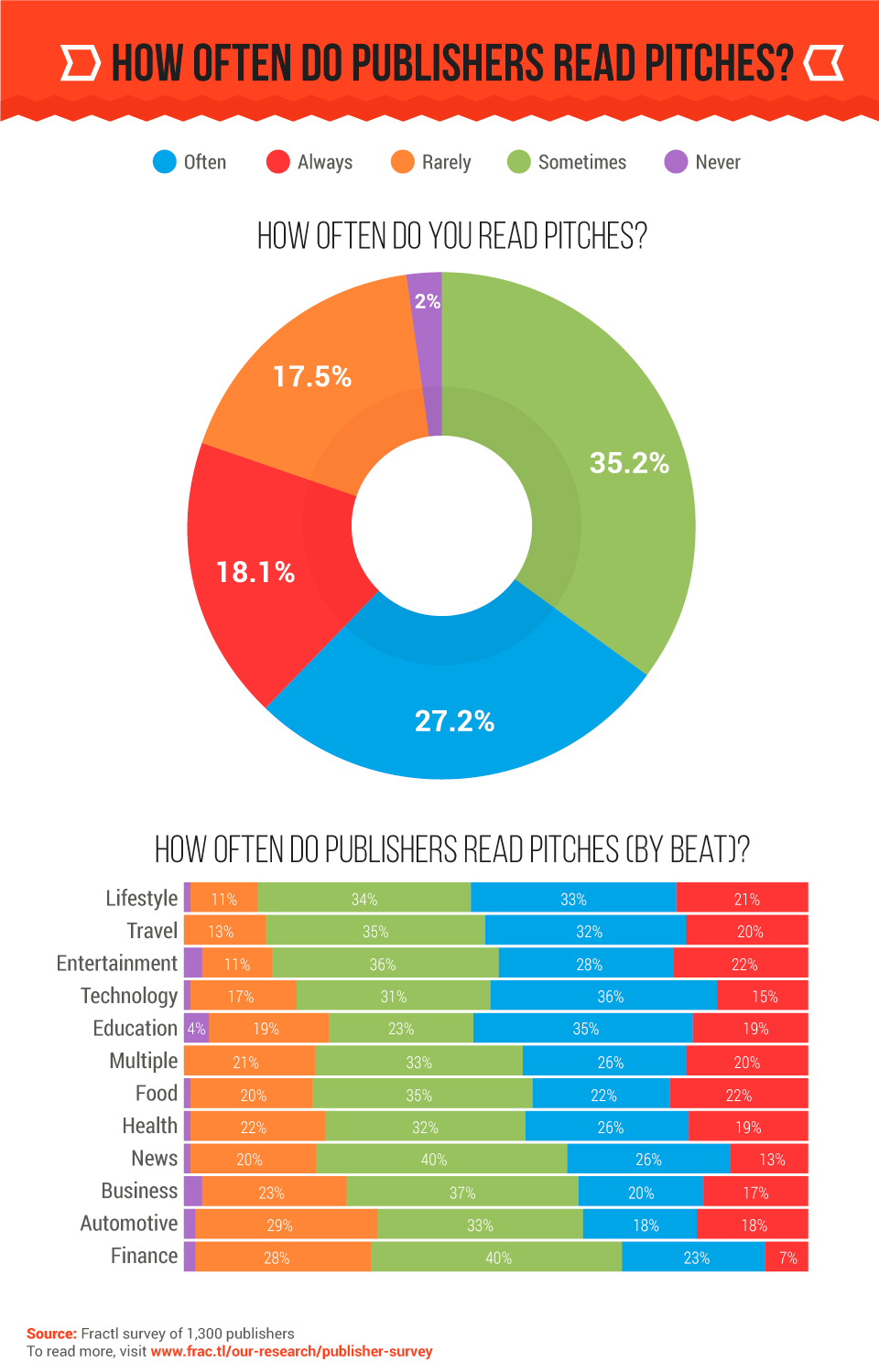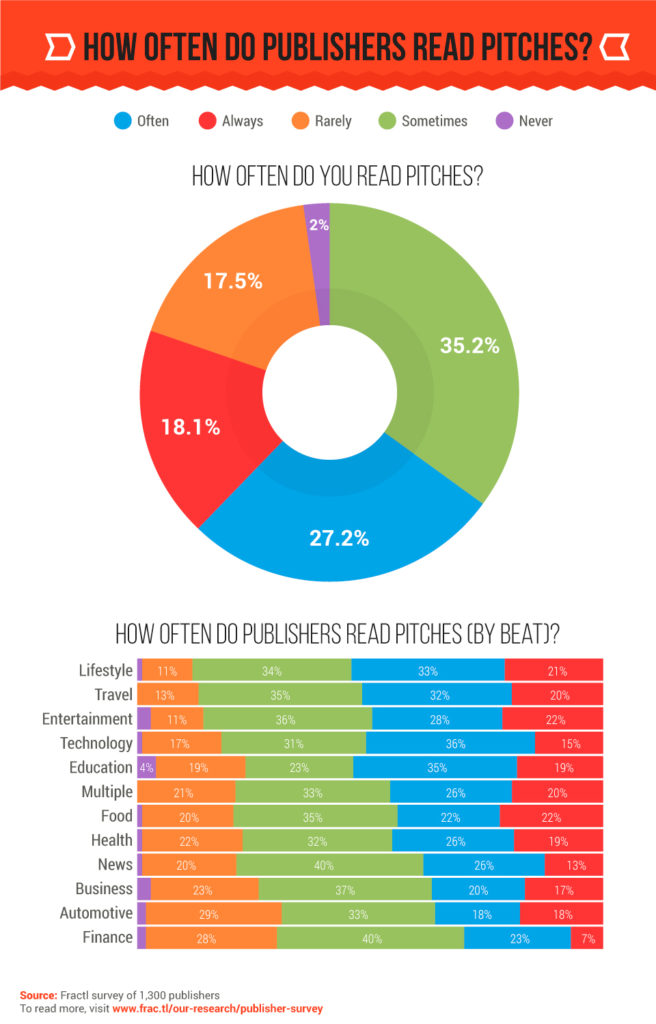There are few things worse than rejection. For media relations professionals, those rejections usually come in form of an email in response to a pitch (or even worse, the lack of one altogether.) Considering 57% of top-tier publishers receive between 50-500 pitches per week, and the average top-tier writer only writes 5 stories a week (or fewer), the odds of getting a writer to open let alone cover your pitch seem out of reach.
Some of these stats may be sobering, but fortunately nearly one-third of publishers often or always read pitches. My team at Fractl still manages to maintain an impressive response and placement rate for our client work, but we know there’s always room for improvement so we wanted to go straight to the source to learn how to improve our outreach efforts.
We surveyed 1,300 writers, editors, contributors, and reporters at top-tier publications to learn how to improve the value of pitch. Luckily we found there are a few steps we can take in the field of PR and communications to mitigate rejections and encourage long-lasting relationships with publishers and influencers.
The Art of Outreach Begins With the Right Target
The most time-consuming aspect of outreach comes way before you ever start drafting your email, but if you don’t put in the extra effort here, you set yourself up for failure (and potentially becoming blacklisted by publishers for wasting their time.)
According the study, by far one of the biggest pet peeves of the media and journalists is a lack of research and familiarity with the publication, the writer, and their audience. Nearly 80% of publishers surveyed revealed the most likely reason a pitch is declined is irrelevance to their beat, meaning the research stage of pitching must be taken seriously if you’re hoping for a positive reply.
There are a lot of questions you need to answer throughout the outreach process, almost all of them are during the research phase. Based on our trial and errors and rooted deeply in the findings of the survey, here’s a three-step guide to perfecting the art of outreach.
Step 1: Craft the Ideal Audience Persona
Develop an audience persona that characterizes your ideal client and more importantly, where they go online for news, entertainment, and answers to their problems. Evaluate the demographics, goals, and challenges of your current and potential customers and analyze your social community to help with this exercise.
Tip: Collaborate with your sales team to get a better idea about who they consider their ideal consumer or client, and if possible, where the most qualified leads come from in terms of referral traffic.
Step 2: Vet the Best-Fit Publications and Writers
There’s a plethora of tools out there to help you with list building, so don’t think you’re limited to a simple Google search. Once you’re familiar with the online habits of your ideal audience and compile a list of those publications, you’ll need to take into consider further criteria to ensure they’re the best-fit for your pitch.
First and foremost, determine if they even publish third-party content, usually included in their editorial guidelines or about page. Next you’ll want to ensure they post content and subject matter similar to what you’re hoping to pitch. For example, if they’ve never published an infographic, they probably won’t be too keen on the idea of covering yours.
After narrowing down your list, explore the editorial contacts of each publication to find the writer or editor whose beat matches your subject matter and vertical. This means tracking down their online footprint including their current publication, past work, and public social channels like Twitter. Check to see how frequently they post, their articles’ social engagement, and the potential authority of the contact at a publication. Editors typically pull rank over reporters, and staff writers have more influence on editorial decisions than contributors. Make a note of why exactly you chose this contact, it will help you prove your relevancy when it comes time to actually draft up your email.
Tip: Take a look at what publications and writers are covering similar third-party studies by competitors or partners in your industry, and consider if your content would be a match.
Step 3: Track Down the Right Influencers
Beyond publications, your ideal audience persona should also include the influencers they choose to follow. Nearly 75% of marketers consider finding the right influences the most challenging aspect of an influencer strategy, but it’s possible they’re searching in all the wrong places.
Cue the majority illusion. Influencers with huge social followings don’t necessarily see high levels of engagement, rather, influence depends more heavily on having the right connections. Clearly define your goals to help build your influencer strategy and determine who would be the best fit to help. Influencers can range from A-list celebrities to niche experts to brand evangelists, and all can somehow contribute value to your influencer strategy.
The influencer outreach equation begins with searching related hashtags, brands, and posts to find social amplifiers is a great place to start, then searching for the influencers those influencers interact with will further propel reaching the right networks. Again, a plethora of tools and resources exist of influencer list building. BuzzStream Discovery helps you uncover the full extent of an influencer’s online presence is also extremely helpful in vetting influencers.
Like publishers, you’ll want to make sure they are interested in brand partnerships. Look for a press page, past sponsored content, social media and blog mentions, and product reviews for other brands to help spot influencers who are willing to collaborate and most importantly, willing to build long-term relationships.
Tip: Consider the potential of micro-influencers who have established an authoritative and trustworthy image to a small, loyal following that matches your audience persona.
Targeting is only half of the battle, but once you’ve compiled an ideal list of contacts the next phase of crafting the perfect subject line and pitch should come easier. Considering you’ve now become intimately familiar with not only the content you’re pitching, but the contact you’re pitching it to, you’re more likely to write a more meaningful personal connection and a better synopsis of why your content is of value to their audience.

 End-to-end outreach workflow
End-to-end outreach workflow




 Check out the BuzzStream Podcast
Check out the BuzzStream Podcast








2 comments
Hey Ashley, nice post on targeting influencers. For more targeted topics like a cpa exam, I have been more creative by reaching out to business, but also educational sites. It’s getting increasingly harder to get placed on sites nowadays.
Thanks for sharing these Ashley! However, which strategy do you think works best? Pitching a few influencers with huge massive following or many influencers with average number of followers? Would love to know Thanks a lot!